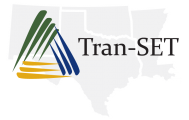Document Type
Data Set
Publication Date
8-1-2019
Abstract
Corresponding data set for Tran-SET Project No. 18HSTSA01. Abstract of the final report is stated below for reference:
"The objectives of this study were to evaluate the vegetative composition and carbon sequestration potential of vegetation along a major roadway in Texas. Soil and vegetation were evaluated along IH-35 within Bexar County for composition and carbon content. Three 20 m transects were placed at each site and percent vegetative cover was estimated and above ground plant biomass, and soil was collected from three 0.25 m2 subplots along each transect. Plant and soil samples were analyzed for carbon content. Two non-native grasses, bermudagrass and King Ranch bluestem, were the dominant cover at all sites accounting for > 90% coverage at several sites. Native plants were rare with only one species, western ragweed, accounting for > 5% mean coverage at all sites. Carbon content of plant species was highest for bermudagrass (699 kg C ha-1) and King Ranch bluestem (401 kg C ha-1), and 6 of 7 sites contained significantly more carbon in non-native plants compared to native plants. The highest native plant carbon content was western ragweed with an average of 15 kg C ha-1. Mean soil carbon content ranged from 3.1 to 6.9 kg C m3 -1 among the sites, and significantly (P < 0.05) greater amounts of carbon were recorded in the upper 0-10 cm compared to the 10-20 cm. The photosynthesis rates of Bermudagrass were significantly greater than rates recorded for King Ranch bluestem indicating the former species is highly adapted to hot semi-arid climate of central Texas, but King Ranch bluestem may gain a competitive advantage along roadways during the spring, fall and periods of increased precipitation. The total available area for the vegetation along the IH-35 highway in Bexar County is estimated to be approximately 81.7 ha (201.5 acres). We suggest the area between sites 5 and 6 (25.1 ha; 62 acres) are ideal locations for carbon sequestration using native plant communities including those with larger diameter woody stems such as trees."
Recommended Citation
Kapoor, V., Hutchinson, J., & Dessouky, S. (2019). Evaluation and Enhancement of Carbon Sequestration Potential of Existing Vegetation along Roadsides. Retrieved from https://repository.lsu.edu/transet_data/41
Included in
Agricultural Economics Commons, Agricultural Science Commons, Botany Commons, Civil Engineering Commons, Transportation Engineering Commons, Viticulture and Oenology Commons


Comments
Tran-SET Project No. 18HSTSA01